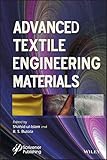Advanced textile engineering materials / edited by Shahid-Ul-Islam, B.S. Butola.
Contributor(s): Ul-Islam, Shahid [editor.] | Butola, B.S. (Bhupendra Sing) [editor.]
| Butola, B.S. (Bhupendra Sing) [editor.] .
.
Material type:  BookPublisher: Hoboken, New Jersey : Salem, Massachusetts : John Wiley & Sons, Inc. ; Scrivener Publishing LLC, [2018]Edition: First edition.Description: 1 online resource.Content type: text Media type: computer Carrier type: online resourceISBN: 9781119488071; 1119488079; 9781119488101; 1119488109; 9781119488118; 1119488117.Subject(s): Textile fabrics
BookPublisher: Hoboken, New Jersey : Salem, Massachusetts : John Wiley & Sons, Inc. ; Scrivener Publishing LLC, [2018]Edition: First edition.Description: 1 online resource.Content type: text Media type: computer Carrier type: online resourceISBN: 9781119488071; 1119488079; 9781119488101; 1119488109; 9781119488118; 1119488117.Subject(s): Textile fabricsDescription based on print version record and CIP data provided by publisher; resource not viewed.
Includes bibliographical references and index.
"Advanced Textile Engineering Materials is written to educate readers about the use of advanced materials in various textile applications. In the first part, the book addresses recent advances in chemical finishing, and also highlights environmental issues in textile sectors. In the second part, the book provides a compilation of innovative fabrication strategies frequently adopted for the mechanical finishing of textiles. Market description: The book is written for readers from diverse backgrounds such as textile chemistry, textile engineering, and materials sciences"-- Provided by publisher.
Intro; Title page; Copyright page; Preface; Part 1: Chemical Aspects; Chapter 1: Application of Stimuli-Sensitive Materials in Smart Textiles; 1.1 Introduction; 1.2 Phase Change Materials; 1.3 Shape Memory Materials; 1.4 Chromic Materials; 1.5 Conjugated Polymers; 1.6 Conductive Polymers; 1.7 Piezoelectricity; 1.8 Optical Fibers; 1.9 Hydrogels; 1.10 Smart Textiles and Nanotechnology; 1.11 Future Trends; References; Chapter 2: Functional Finishing of Textile Materials and Its Psychological Aspects; 2.1 Introduction; 2.2 Softeners; 2.3 Oil- and Water-Repellent Finishes; 2.4 Fire Retardants
2.5 Easy Care Finishing2.6 Psychological Aspect of Functional Textiles; 2.7 Challenges and Future Directions; 2.8 Conclusion; References; Chapter 3: Recent Advances in Protective Textile Materials; 3.1 Introduction; 3.2 Application of the Protective Textile in the Defense Arena; 3.3 Recent Advancements in Engineering to Create UV-Protective Textiles; 3.4 Insect-Repellent Textiles; 3.5 Microorganism Protective Textile Materials; 3.6 Camouflage Application as Protective Textile; 3.7 Challenges and Future Directions; References
Chapter 4: Antibacterial Aspects of Nanomaterials in Textiles: From Origin to Release4.1 Introduction; 4.2 Nanomaterial Properties; 4.3 Release; 4.4 Conclusion; Acknowledgment; References; Chapter 5: Modification of Wool and Cotton by UV Irradiation for Dyeing and Finishing Processes; 5.1 Introduction; 5.2 Interaction of UV Radiation with Textile Fibers; 5.3 Interaction of UV Radiation with Naturally Present Chromophores of Different Fibers; 5.4 UV Irradiation on Wool; 5.5 UV Irradiation on Cotton; 5.6 Conclusions; 5.7 Future Perspectives; References; Chapter 6: Electroconductive Textiles
6.1 Introduction6.2 Electrical Conductivity; 6.3 The Source of Conductivity in Conducting Polymers; 6.4 Electroconductive Textiles Based on Metals; 6.5 Electroconductive Textiles Based on Graphene; 6.6 Electroconductive Textile Based on PPy; 6.7 Conductive Polymer-Based Textiles; 6.8 Effect of Various Yarns and Fabrics as Substrate; 6.9 Applications of Electroconductive Textiles; 6.10 Durability Properties of Conductive Polymer-Based Textiles; 6.11 Future Scope and Challenges; 6.12 Conclusions; References; Chapter 7: Coated or Laminated Textiles for Aerostat and Stratospheric Airship
7.1 Introduction7.2 Global Competitors for Making Aerostat/Airship at Present; 7.3 Working Atmosphere of Aerostats and High Altitude Airship (HAA); 7.4 Materials Used in LTA Envelopes; 7.5 Case Studies on Different Coated or Laminated LTA Envelopes; 7.6 Advanced Polymer Nanocomposites as Potential Material for LTA Envelopes; 7.7 Models for Predicting the Performance and Service Life of Aerostats/Airships; 7.8 Challenges and Future Scopes; 7.9 Conclusion; References; Chapter 8: Woolen Carpet Industry: Environmental Impact and Recent Remediation Approaches; 8.1 Introduction


There are no comments for this item.